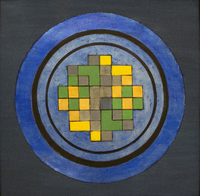Jeanne Miles
Not Dated
Handground oil paint and gold leaf on acrylic
24 in. x 24 in.
Gift of Michael Brandman
Jeanne Miles was a painter and sculptor who lived between 1908 and 1999.1 She was born in Baltimore, and originally studied at George Washington University.2 She lived and worked in Paris in the 1940s, and during this time was mentored by the fauvist painter Marcel Gromaire (1892-1971).3 She was eventually part of a group of artist refugees who made their way to New York from Europe during the stirrings of World War II.4 In 1943 Betty Parsons sponsored Miles’ first one woman exhibition at the Wakefield Gallery in New York City. Miles taught at Oberlin College, Ohio in 1952, but moved to teach at the New York Institute of Technology by the late 1960s.5 Throughout her career she also taught at both Moravian College and Yale University.6 Miles received numerous grants and awards including the following: the 1960 American Institute of Arts and Letters Award, the 1970 and 1973 Mark Rothko Awards, the 1974 Pelham von Stdeffler Art Fund Grant,7 and grants from both the Yaddo Art Colony and the McDowell Art Colony.8 Her work is housed in the permanent collections of the Cincinnati Art Museum, the Guggenheim, the Los Angeles County Museum of Art, the Newark Museum,9 the Santa Barbara Museum, the Corcoran in Washington, D.C., the Arizona University Museum in Tucson.10
While Miles had been a member of the cooperative exhibition group, The American Abstract Artists, since 1959, over time her visual language increasingly focused on geometric shapes and purist forms.11 The elemental shapes of circles, squares, and triangles organized into mandalas grew in prevalence to her body of work, especially as she began to study the mystical theories of P. Ouspensky and esotericism.12 It is at this point in her developing visual language that Blue Mandala can be placed. Squares stack on top of one another to form a halting, angular, circular form. The boundaries between these squares are sometimes strong with thick black lines to separate them - and sometimes weak when squares of like colors radiate from within themselves and blur their distinctions. These blurrings are not random, but circularly symmetric. Fold the circle into fourths and each segment lines up. The entirety of the tile-like squares are immersed in shades of blue, and then encompassed by two concentric black circles that keep the deepest of the blue at bay. These circles are then necessarily outlined and contained by the square boundaries of the paper. As Miles stated in a 1977 interview with Arts Magazine, these geometric forms (squares making circles, and circles inside squares) represent the order of the universe - not symbolically but essentially.13 While Miles’s thick black lines and use of gold leaf make reference to the spiritual gravity of an icon or stained glass window, the difference is that the materiality and existence of Blue Mandala do not symbolically denote but rather fundamentally assert essential truths.
1. Charlotte Streifer Rubinstein, American Women Artists (New York: G.K Hall, 1982), 298.↩
2. Ibid, 298.↩
3. James H. Beck, “Jeanne Miles: The Painter and the Painting,” Arts Magazine 51:8 (1977): 4.↩
4. Rubinstein, American Women Artists, 298.↩
5. Mary R. Davis, “Jeanne Miles: An Interview with Mary R. Davis” Arts Magazine 51:8 (1977), 1-3.↩
6. Holland Cotter, “Jeanne Miles, 90, Abstract Artist Inspired by Asian Art and Ideas,” The New York Times. September 3, 1999. Accessed November 3, 2016. http://www.nytimes.com/1999/09/03/arts/jeanne-miles-90-abstract-artist-inspired-by-asian-art-and-ideas.html↩
7. Ibid.↩
8. Myrna Oliver, “Obituaries : Jeanne Miles; Abstract Artist for Half a Century,” The Los Angeles Times. September 1, 1999. Accessed November 3, 2016.http://articles.latimes.com/1999/sep/01/news/mn-5653↩
9. Cotter, “Jeanne Miles,” The New York Times.↩
10. Oliver, “Obituaries: Jeanne Miles” The Los Angeles Times.↩
11. Davis, “Jeanne Miles” Arts Magazine.↩
12. Rubinstein, American Women Artists, 299.↩
13. Davis, “Jeanne Miles” Arts Magazine.↩
-Emily Smith

